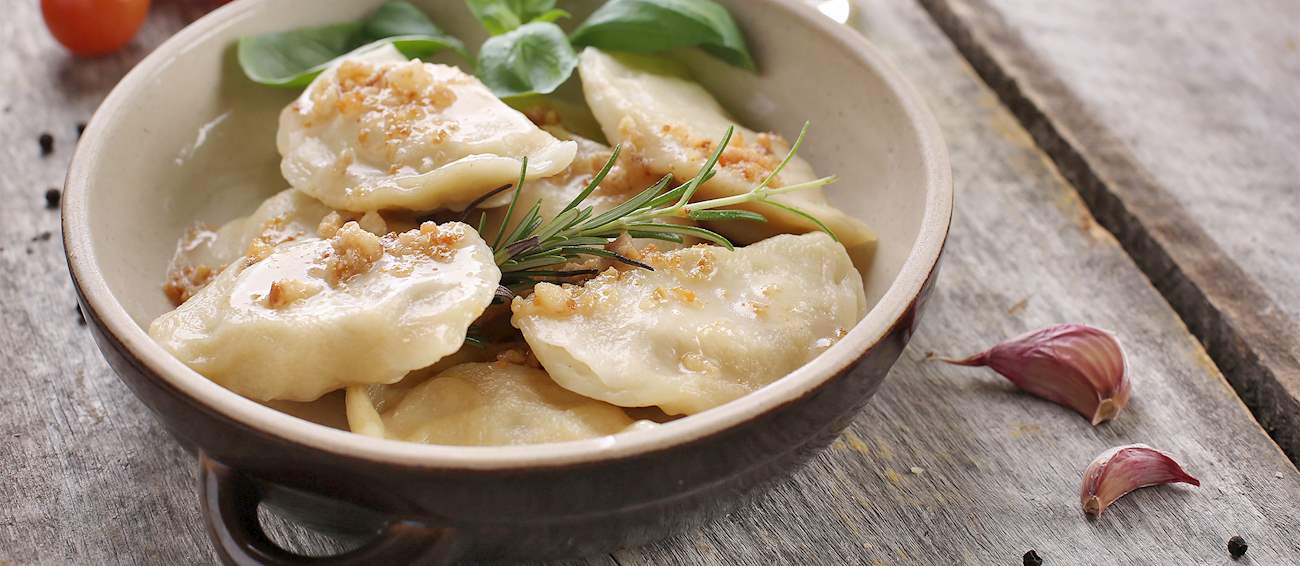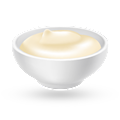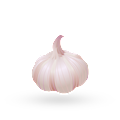MAIN INGREDIENTS
Kepta duona is a simple Lithuanian snack consisting of sliced rye bread that is shortly fried until crispy. The bread is usually sliced into thin strips before it is pan-fried in oil, and it is usually rubbed with garlic (duona su česnaku), while modern varieties often come topped with cheese (duona su sūriu) or mayonnaise.
This snack is commonly served in bars, and it is often paired with beer or gira (kvass).
Known as koldūnai in Lithuania, kalduny in Belarus and kołduny in Poland, these stuffed dumplings boiled in salted water are a staple of regional cuisine. Traditionally filled with minced pork, beef, chicken, curd cheese, or mushrooms, they make for an excellent lunch choice and can be enjoyed with a variety of garnishes, from butter and black pepper to mayonnaise, sour cream, crispy bacon, or spirgučiais (a type of pork rind).
MAIN INGREDIENTS
Even though it is very much alike the famous Italian chocolate salami, this simple, no-bake dessert, translated as the lazy man is regarded as an authentic Lithuanian delicacy. It is prepared with a blend of crumbled cookies, cocoa, condensed milk, butter, and sugar, shaped into the desired form, and left to set.
According to a widely accepted anecdote, tinginys was created by accident, but immediately became the nation’s favorite. Because of its neutral taste, it is easily adjusted with additional ingredients, such as nuts or dry fruit. It is recommended to enjoy tinginys with a cup of coffee or tea on the side.
Syrniki is a dessert consisting of fried cottage cheese pancakes that are usually garnished with honey, fruit jam, sour cream, or applesauce. It is part of the Russian (where it's sometimes also called tvorozhniki), Belarusian, Ukrainian, Latvian and Lithuanian cuisine.
Cottage cheese is traditionally first swetened with sugar, then combined with flour into a dough which is fried in hot oil until it develops a golden-brown color. Syrniki can be served for breakfast or consumed as a tasty dessert after a large meal.
Bulviniai blynai are traditional, crispy and mouth-watering Lithuanian potato pancakes. The combination of grated potatoes, diced onions, eggs, and flour is seasoned with salt and pepper and sometimes flavored with lemon juice before being fried until it develops a beautiful, golden color.
Popular with both old and young, bulviniai blynai are served with sour cream, applesauce, or jam. This treat is often served at the Christmas table, and it is also a beloved Hannukkah snack.
These traditional Lithuanian pastries are made with a dough that is enriched with butter, eggs, and either kefir or sour cream. The dough is hand-rolled, and it is traditionally filled with minced mutton that is flavored with onions and various herbs.
It is then firmly pinch-sealed into crescent-shaped pockets. Kibinai are particularly popular with the Karaim ethnic minority in Lithuania, and they're primarily associated with the city of Trakai.
Liliputas is a handmade, semi-hard, naturally ripened cheese made from pasteurized cow's milk in the village of Belvederis in Lithuania. The cheese has a very high fat content of 50% and must mature for at least one month in cheese cellars.
It is wrapped in cotton cloths and pressed into cylindrical molds. Liliputas got its name because of its small size and weight, which is between 0,4 to 0,7 kilograms. The exterior is smooth and thin, with a waxy rind and a firm, yet elastic texture and an acidic, fresh, slightly sharp and salty flavor, typical for a fermented cheese.
Žemaičių blynai is a traditional dish, and the name translates to Samogitian pancakes. These flat potato pancakes are made from eggs, salt, and coarsely mashed, riced, or grated potatoes, and they're filled with carrots or meat. The filling is often made with diced pork, eggs, and pepper.
Once prepared, these oval-shaped potato pancakes are dipped in flour and fried in oil until golden brown. They're served with a dollop of sour cream, extra bits of bacon, sliced cucumbers, or beetroot salad. Žemaičių blynai can be served as they are or as an accompaniment to meat, fish, or egg dishes.
MAIN INGREDIENTS
Kartupeļu pankūkas are Latvian potato pancakes, a quick mid-week meal that almost everyone knows how to prepare. They are made with a combination of grated potatoes, eggs, and flour, seasoned only with salt and pepper. Fried until golden brown, kartupeļu pankūkas are traditionally served with sour cream and lingonberry sauce.
Although these pancakes were considered a cheap meal, they have recently started to appear on many coffee shop menus in the country.
MAIN INGREDIENTS
Ķiploku grauzdiņi is a traditional snack and the Latvian version of garlic bread. In order to prepare it, rupjmaize rye bread is cut into slices, then pan-fried in butter or oil on both sides for a few minutes. The slices are removed from the pan, drained on paper towels, then rubbed with garlic cloves on both sides. Ķiploku grauzdiņi can also be baked in the oven, and the slices are then just drizzled with oil or smeared with butter.
Before serving, this Latvian garlic bread is sprinkled with salt. It's recommended to serve it with a glass of cold beer on the side.
TasteAtlas food rankings are based on the ratings of the TasteAtlas audience, with a series of mechanisms that recognize real users and that ignore bot, nationalist or local patriotic ratings, and give additional value to the ratings of users that the system recognizes as knowledgeable. For the “Top 57 Baltic Foods” list until February 16, 2025, 3,956 ratings were recorded, of which 1,983 were recognized by the system as legitimate. TasteAtlas Rankings should not be seen as the final global conclusion about food. Their purpose is to promote excellent local foods, instill pride in traditional dishes, and arouse curiosity about dishes you haven’t tried.




















































